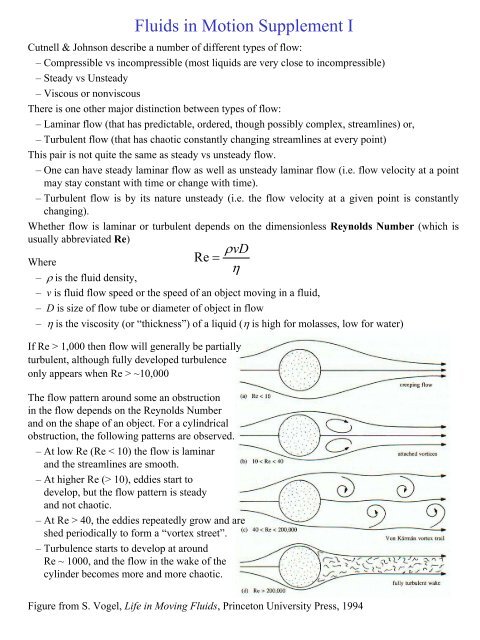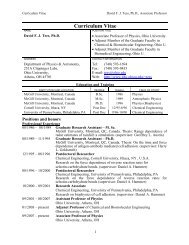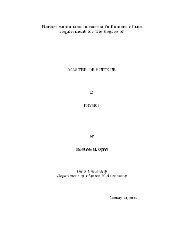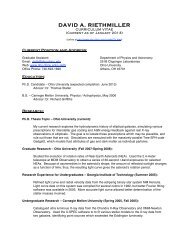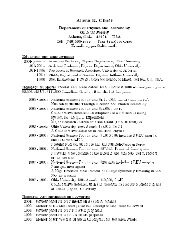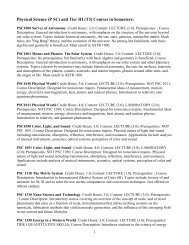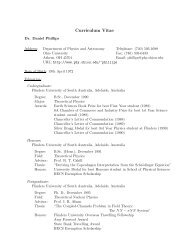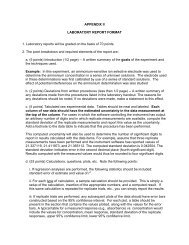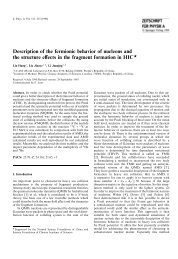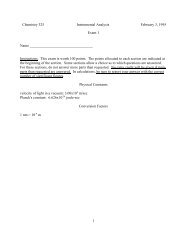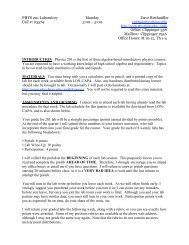Fluids in Motion Supplement I
Fluids in Motion Supplement I
Fluids in Motion Supplement I
You also want an ePaper? Increase the reach of your titles
YUMPU automatically turns print PDFs into web optimized ePapers that Google loves.
<strong>Fluids</strong> <strong>in</strong> <strong>Motion</strong> <strong>Supplement</strong> I<br />
Cutnell & Johnson describe a number of different types of flow:<br />
– Compressible vs <strong>in</strong>compressible (most liquids are very close to <strong>in</strong>compressible)<br />
– Steady vs Unsteady<br />
– Viscous or nonviscous<br />
There is one other major dist<strong>in</strong>ction between types of flow:<br />
– Lam<strong>in</strong>ar flow (that has predictable, ordered, though possibly complex, streaml<strong>in</strong>es) or,<br />
– Turbulent flow (that has chaotic constantly chang<strong>in</strong>g streaml<strong>in</strong>es at every po<strong>in</strong>t)<br />
This pair is not quite the same as steady vs unsteady flow.<br />
– One can have steady lam<strong>in</strong>ar flow as well as unsteady lam<strong>in</strong>ar flow (i.e. flow velocity at a po<strong>in</strong>t<br />
may stay constant with time or change with time).<br />
– Turbulent flow is by its nature unsteady (i.e. the flow velocity at a given po<strong>in</strong>t is constantly<br />
chang<strong>in</strong>g).<br />
Whether flow is lam<strong>in</strong>ar or turbulent depends on the dimensionless Reynolds Number (which is<br />
usually abbreviated Re)<br />
Where<br />
Re =<br />
ρvD<br />
η<br />
– ρ is the fluid density,<br />
– v is fluid flow speed or the speed of an object mov<strong>in</strong>g <strong>in</strong> a fluid,<br />
– D is size of flow tube or diameter of object <strong>in</strong> flow<br />
– η is the viscosity (or “thickness”) of a liquid (η is high for molasses, low for water)<br />
If Re > 1,000 then flow will generally be partially<br />
turbulent, although fully developed turbulence<br />
only appears when Re > ~10,000<br />
The flow pattern around some an obstruction<br />
<strong>in</strong> the flow depends on the Reynolds Number<br />
and on the shape of an object. For a cyl<strong>in</strong>drical<br />
obstruction, the follow<strong>in</strong>g patterns are observed.<br />
– At low Re (Re < 10) the flow is lam<strong>in</strong>ar<br />
and the streaml<strong>in</strong>es are smooth.<br />
– At higher Re (> 10), eddies start to<br />
develop, but the flow pattern is steady<br />
and not chaotic.<br />
– At Re > 40, the eddies repeatedly grow and are<br />
shed periodically to form a “vortex street”.<br />
– Turbulence starts to develop at around<br />
Re ~ 1000, and the flow <strong>in</strong> the wake of the<br />
cyl<strong>in</strong>der becomes more and more chaotic.<br />
Figure from S. Vogel, Life <strong>in</strong> Mov<strong>in</strong>g <strong>Fluids</strong>, Pr<strong>in</strong>ceton University Press, 1994
<strong>Fluids</strong> <strong>in</strong> <strong>Motion</strong> <strong>Supplement</strong> I<br />
Viscosity:<br />
– SI units of viscosity, η = kg m -1 s -1 or Pa·s (cgs unit: Poise, P = g cm -1 s -1 = 0.1 Pa s)<br />
– Viscosity varies with Temperature<br />
Material<br />
Viscosity (Pa·s)<br />
Air (20 C): 0.000018<br />
Water (20°C):<br />
0.001 Pa s (=1 cP)<br />
Water (40°C): 0.00065<br />
Ethanol: 0.0012<br />
Methanol: 0.00058<br />
Glycer<strong>in</strong> (0°C): 12.0<br />
Glycer<strong>in</strong> (30°C): 0.629<br />
Oil, Olive (20°C): 0.084<br />
30% aqueous Sucrose: 0.003<br />
Molasses (45-50% Sucrose) 0.005-0.010<br />
70% aqueous Sucrose: 0.481<br />
Example S1 Reynolds Number for a baseball pitch<br />
Baseball pitchers can rout<strong>in</strong>ely throw baseballs at speeds of 90 mph (40.2 m/s). The diameter of a<br />
baseball is supposed to be 7.37 cm1.8 x 10 -5 Pa·s. The density of air is 1.29 kg/m 3 and the viscosity<br />
of air is 1.8 x 10 -5 Pa·s.<br />
a) What is the Reynolds Number for a fastball?<br />
b) Will the flow past the ball be lam<strong>in</strong>ar or turbulent?<br />
Reason<strong>in</strong>g: This is a straight plug-<strong>in</strong> problem us<strong>in</strong>g the def<strong>in</strong>ition of Reynolds Number. From the<br />
notes on the previous page, the def<strong>in</strong>ition of Reynolds number is:<br />
ρvD<br />
Re =<br />
η<br />
where<br />
ρ is the fluid density (not the baseball density),<br />
v is speed of the air around the baseball, or, equivalently for the baseball problem, the speed of<br />
the baseball through the air<br />
D is diameter of the baseball (given as 7.37 cm)<br />
η is the viscosity of the air (from the <strong>in</strong>formation given, η = 1.8 x 10 -5 Pa·s).<br />
Solution:<br />
a) The Reynolds number can be calculated us<strong>in</strong>g the values above:<br />
3<br />
ρvD (1.29 kg/m )(40.2 m/s)(0.0737 m)<br />
Re = = = 2.12×<br />
10<br />
-5<br />
η<br />
1.8× 10 kg/(m ⋅s)<br />
b) S<strong>in</strong>ce Re is 212,000, which is much greater than 1000 (the Reynolds Number above which flow<br />
becomes turbulent) the flow around the baseball will be turbulent.<br />
5
<strong>Fluids</strong> <strong>in</strong> <strong>Motion</strong> <strong>Supplement</strong> I<br />
Some examples of Reynolds Numbers for biological organisms mov<strong>in</strong>g through fluids (air or water)<br />
are shown <strong>in</strong> the table below. These values were calculated <strong>in</strong> much the same way as for the<br />
baseball, but they use very rough estimates for the size of the organisms.<br />
A large whale swimm<strong>in</strong>g at 10 m/s 300,000,000<br />
A duck fly<strong>in</strong>g at 20 m/s 300,000<br />
A large dragonfly mov<strong>in</strong>g at 7 m/s 30,000<br />
Flapp<strong>in</strong>g w<strong>in</strong>gs of the smallest fly<strong>in</strong>g <strong>in</strong>sect 30<br />
An <strong>in</strong>vertebrate larva, 0.3 mm long, at 1 mm/s 0.3<br />
A sea urch<strong>in</strong> sperm mov<strong>in</strong>g at 0.2 mm/s 0.03<br />
A bacterium, swimm<strong>in</strong>g at 0.01 mm/s 0.00001<br />
(From S. Vogel, Life <strong>in</strong> Mov<strong>in</strong>g <strong>Fluids</strong>, Pr<strong>in</strong>ceton University Press, 1994, Table 5.1)<br />
One can f<strong>in</strong>d the size of the whale implied by the first item <strong>in</strong> the table above from the def<strong>in</strong>ition of<br />
the Reynolds Number. If Re = 3 x 10 8 , then us<strong>in</strong>g values for the density of water from Table 11.1 <strong>in</strong><br />
Cutnell & Johnson (ρ water = 1000 kg/m 3 ) and the viscosity of water from the table on the previous<br />
page of this supplement (η water = 0.001 Pas):<br />
8<br />
Re η (3× 10 )(0.001 kg/(m ⋅s))<br />
D = = = 30 m<br />
3<br />
ρv<br />
(1000 kg/m )(10 m/s)<br />
A size of 30 m is consistent with the length of a large whale. For a complex shape like a whale the<br />
size scale to use <strong>in</strong> the calculation of the Reynolds Number is a matter of debate, even among<br />
experts. It is not always clear whether one should one set D equal to the width of the whale, or the<br />
length of the whale, or the height of the whale (or some comb<strong>in</strong>ation of the three). In most cases,<br />
however, the Reynolds Number will not change enough to affect what type of flow (lam<strong>in</strong>ar or<br />
turbulent) is predicted by the Re value if the width of the whale is used <strong>in</strong>stead of the length. The<br />
true flow pattern can only be found by experiment or from the study of scale models <strong>in</strong> w<strong>in</strong>d or<br />
water tunnels.<br />
The idea that if Reynolds Number is the same for two objects of different sizes, flow patterns will be<br />
the same leads to the idea of dynamic similarity. This implies that one can measure the flow<br />
pattern for a scale model of an object <strong>in</strong> a w<strong>in</strong>d tunnel and expect that the flow pattern around the<br />
full-sized object will be similar if the density, viscosity or speed of the w<strong>in</strong>d tunnel fluid are<br />
adjusted to give the same Reynolds Number as the full-sized object.
Poiseuille Flow (Low Re flow <strong>in</strong> Tubes)<br />
Jean Poiseuille (1797-1869), a medical doctor, studied flow <strong>in</strong> circular tubes at low Reynolds<br />
number <strong>in</strong> order to understand the flow of blood <strong>in</strong> arteries, capillaries and ve<strong>in</strong>s. He found that<br />
thanks to viscosity (which can be thought of as friction between layers of fluid), flow is fastest at<br />
the tube center-l<strong>in</strong>e and the flow velocity is zero at the tube wall.<br />
To visualize flow <strong>in</strong> tubes, look at Fig. 11.37 <strong>in</strong> Cutnell & Johnson and imag<strong>in</strong>e concentric<br />
cyl<strong>in</strong>ders of fluid at different distances, r, from the centerl<strong>in</strong>e <strong>in</strong> a tube of radius R. If one looks a<br />
a cross section down the length of the tube, the flow profile (or velocity, v(r), as a function of<br />
distance from the centerl<strong>in</strong>e) is a parabola, as shown <strong>in</strong> the figure at the bottom of this page. The<br />
parabolic flow velocity profile can be summarized with the follow<strong>in</strong>g equation:<br />
⎛<br />
v= v ⎜1−<br />
r<br />
⎝ R<br />
At the tube wall, where r = R, one gets that v = v max (1 – R 2 /R 2 ) = v max (1 – 1) = 0. At the tube<br />
centerl<strong>in</strong>e where r = 0, one gets that v = v max . It can be shown that the v max is:<br />
max<br />
The AVERAGE fluid velocity, turns out to be just half v max :<br />
v<br />
v<br />
This is important s<strong>in</strong>ce the total flow rate (used <strong>in</strong> the equation of cont<strong>in</strong>uity is related to the<br />
AVERAGE velocity, not the maximum.<br />
Rearrang<strong>in</strong>g this equation, we get the equation at Cutnell & Johnson call Poiseuille’s Law. Other<br />
books call it the Poiseuille-Hagen Law to acknowledge the co-discoverer:<br />
2<br />
max 2<br />
2<br />
R ∆P<br />
=<br />
4η<br />
L<br />
⎞<br />
⎟<br />
⎠<br />
2<br />
1 R ∆P<br />
= vmax<br />
=<br />
2 8η<br />
L<br />
2<br />
2<br />
⎛ R ∆P⎞<br />
Q= Atube<br />
v = ( π R ) ⎜ ⎟<br />
⎝8η<br />
L ⎠<br />
4<br />
π R<br />
Q =<br />
8η<br />
∆P<br />
L<br />
R<br />
r<br />
v(r)<br />
centerl<strong>in</strong>e<br />
v max
Drag on an Object<br />
Bernoulli’s Law describes the lift on an object fairly well (i.e. the pressure difference between the<br />
top and bottom of an object <strong>in</strong> flow). It does not do so well for the drag on an object.<br />
Bernoulli’s law applies for “ideal fluids” (i.e. fluids with zero viscosity), but neither air nor water<br />
(the most common fluids encountered on the earth’s surface) are ideal fluids. Both have viscosity<br />
that produces frictional drag. This adds a non-conservative work term to the conservation of energy<br />
formulation that underlies Bernoulli’s Law. Thanks to viscosity, work has be done to get fluids to<br />
move around objects and this leads to a pressure difference between the front and back of the object<br />
(relative to the flow). Drag is caused by this difference <strong>in</strong> pressure between the front and back of an<br />
object.<br />
Experiments show that the drag force, F d , on an object will depend on:<br />
– Area and shape of the object<br />
– Speed with which the object moves relative to fluid<br />
– Density of the fluid<br />
– Reynolds Number<br />
The standard procedure to calculate drag on an object is to use a modified form of Bernoulli’s Law<br />
to f<strong>in</strong>d the force from the Bernoulli Pressure. For a spherical particle <strong>in</strong> flow, if A is the crosssectional<br />
area of the object and ½ρv 2 is the Bernoulli Pressure at the front of the object (where v is<br />
the object’s speed relative to the fluid), then the drag force will be:<br />
⎛1<br />
⎞<br />
= ⎜ ⎟<br />
⎝2<br />
⎠<br />
2<br />
Fd<br />
A ρv Cd<br />
We put <strong>in</strong> a new factor, C d the drag coefficient, to take <strong>in</strong>to account the viscous losses.<br />
Drag coefficient changes with Reynolds Number and is different for differently shaped objects<br />
Drag coefficients can be measured <strong>in</strong> w<strong>in</strong>d tunnel tests or they can be calculated (us<strong>in</strong>g computers<br />
to solve the extremely complex equations of hydrodynamics).<br />
If the object <strong>in</strong> question is a sphere, experiments show that for high Re (>~1000):<br />
C ≈ 0.44<br />
d<br />
So the drag equation for a sphere of radius R (where the cross-sectional area is πR 2 ) at high Re<br />
becomes:<br />
⎛1<br />
Fd<br />
R v<br />
⎝2<br />
2 2<br />
= π ⎜ ρ ⎟<br />
( 0.44)<br />
Example S2 Drag on the baseball <strong>in</strong> Example S1<br />
This equation would apply, for example, to the baseball <strong>in</strong> Example S1, for which Re ~200,000. For<br />
this v = 40.2 m/s. The diameter of a baseball is supposed to be 7.37 cm, so the radius of the ball is<br />
(0.0737 m)/2 = 0.0368 m. The density of air is 1.29 kg/m 3 so:<br />
2⎛1 2⎞<br />
2 1<br />
3 2<br />
Fd<br />
= πR ⎜ ρv<br />
⎟( 0.44 ) = π(0.0368 m) (1.29 kg/m )(40.2 m/s) ( 0.44)<br />
= 1.95 N<br />
⎝2 ⎠<br />
2<br />
⎞<br />
⎠
Fluid Drag at Low Reynolds Number<br />
For very low Reynolds Number (Re < 0.1 – this regime is called creep<strong>in</strong>g flow), the drag<br />
coefficient for a sphere has been shown to be:<br />
C<br />
d<br />
=<br />
24<br />
Re<br />
where Re is the Reynolds Number = Dvρ/η. Plugg<strong>in</strong>g this <strong>in</strong>to the drag equation on the previous<br />
page, and us<strong>in</strong>g the cross-sectional area of a sphere<br />
⎛1 2⎞ 2⎛1 2⎞<br />
24<br />
Fd<br />
= A⎜ ρv ⎟Cd<br />
= πR ⎜ ρv<br />
⎟<br />
⎝2 ⎠ ⎝2 ⎠ 2 /<br />
(note that D = 2R has been used here). There is a lot of cancellation and we get the f<strong>in</strong>al<br />
expression for the Stokes drag, or drag on a sphere at very low Reynolds Number:<br />
Fd<br />
= 6πη<br />
Rv<br />
This expression was calculated by Stokes <strong>in</strong> 1850 for the drag force on a sphere of radius R<br />
mov<strong>in</strong>g with speed v relative to a medium with viscosity η. This expression only applies to a<br />
sphere, but other shapes have drag forces that have similar forms at low Reynolds Number.<br />
Objects with densities ρ 1 that differ from the density, ρ 2 , of the surround<strong>in</strong>g medium will either<br />
s<strong>in</strong>k (if ρ 1 more dense than ρ 2 ) or float (if ρ 1 less dense than ρ 2 ).<br />
For objects sediment<strong>in</strong>g <strong>in</strong> fluids three forces act<strong>in</strong>g on the particle:<br />
– Gravity, F g = mg = ρ 1 Vg<br />
– Buoyant force, F b = m fluid displaced g = ρ 2 Vg<br />
– Hydrodynamic drag, F d<br />
( Rvρ η)<br />
Sedimentation and Term<strong>in</strong>al Velocity<br />
The drag force <strong>in</strong>creases with speed and so if a particle starts at rest, it will accelerate until the<br />
drag force equals the sum of the gravitational and buoyant forces. At this po<strong>in</strong>t the object will<br />
move with a constant velocity. Choos<strong>in</strong>g down to be negative, the force balance is then:<br />
∑ Fy = Fd + Fb − Fg<br />
= 0 F d F b<br />
Plugg<strong>in</strong>g <strong>in</strong> for F g and F b , we get:<br />
F + ρ gV − ρ gV =<br />
d<br />
2 1<br />
0<br />
ρ 1<br />
ρ 2<br />
We can rearrange to get the fluid drag at term<strong>in</strong>al velocity is given by:<br />
Fd<br />
( ρ ρ )<br />
= −<br />
1 2<br />
gV<br />
F g
Sedimentation of a Sphere at high Re<br />
Suppose a spherical object with density ρ 1 is s<strong>in</strong>k<strong>in</strong>g (or float<strong>in</strong>g) with<strong>in</strong> a fluid. At high<br />
Reynolds Number, the drag force is given by the modified Bernoulli drag:<br />
2⎛1<br />
2⎞<br />
Fd<br />
= πR ⎜ ρ<br />
fluidv<br />
⎟<br />
⎝2<br />
⎠<br />
Plugg<strong>in</strong>g this <strong>in</strong>to the sedimentation force balance on the previous page and us<strong>in</strong>g the formula for<br />
the volume and area of a sphere:<br />
2 1 2 4 3<br />
πR ⎛ ⎜ ρ2v ⎞ ⎟( 0.44) = ( ρ1−ρ2)<br />
g ⎛ ⎜ πR<br />
⎞<br />
⎟<br />
⎝2 ⎠ ⎝3<br />
⎠<br />
There is a lot of cancellation here and one may then solve for the term<strong>in</strong>al velocity of the<br />
sediment<strong>in</strong>g sphere.<br />
v<br />
8 Rg ⎛ ρ − ρ ⎞<br />
g<br />
⎝ ⎠<br />
1 2<br />
= ⎜ ⎟<br />
3 C d<br />
ρ2<br />
( 0.44)<br />
Example S3 S<strong>in</strong>k<strong>in</strong>g speed of a cannonball <strong>in</strong> water<br />
Suppose you have a 3 kg iron cannonball s<strong>in</strong>k<strong>in</strong>g <strong>in</strong> water. What is its term<strong>in</strong>al velocity?<br />
First, f<strong>in</strong>d the radius of the cannonball. S<strong>in</strong>ce the density of iron is 7860 kg/m 3 :<br />
So:<br />
S<strong>in</strong>ce this radius is fairly large and the s<strong>in</strong>k<strong>in</strong>g speed (which we know from experience) will be<br />
reasonably large, say 1 m/s, the Reynolds number = Dvρ/η ~ (2*0.045)(1)(1000)/(.001) ~ 90,000.<br />
One can thus use the high Re formula for sedimentation:<br />
v<br />
We f<strong>in</strong>ally get:<br />
R<br />
cannonball<br />
8 Rg ⎛ ρ −ρ<br />
⎞ 8 (0.0450)(9.80) ⎛7860 −1000<br />
⎞<br />
⎜ ⎟ ⎜ ⎟<br />
3 ⎝ ⎠ 3 (0.44) ⎝ 1000 ⎠<br />
1 2<br />
= =<br />
Cd<br />
ρ2<br />
m 4 V<br />
3<br />
cannonball π R<br />
cannonball<br />
ρ = = 3<br />
= 3m<br />
33.00 ( kg)<br />
3 3<br />
0.0450 m<br />
3<br />
4πρ<br />
= 4π<br />
7860 kg/m<br />
=<br />
( )<br />
v = 4.28 m/s
Sedimentation of a Sphere at low Re<br />
Suppose a spherical object with density ρ 1 is s<strong>in</strong>k<strong>in</strong>g (or float<strong>in</strong>g) with<strong>in</strong> a fluid. At low Reynolds<br />
Number, the drag force is given by the Stokes drag, so:<br />
F d<br />
= 6πηRv<br />
Plugg<strong>in</strong>g this <strong>in</strong> and us<strong>in</strong>g the formula for the volume of a sphere:<br />
4<br />
6πη π ρ ρ<br />
3<br />
( )<br />
3<br />
Rv= R<br />
1−<br />
2<br />
g<br />
There is only a little cancellation and one may then solve for the term<strong>in</strong>al velocity of a sphere<br />
sediment<strong>in</strong>g if the Reynolds Number is less than 1.<br />
v =<br />
2<br />
9<br />
R<br />
2<br />
( ρ − ρ )<br />
1 2<br />
η<br />
g<br />
Example S4 Sedimentation time for a cell <strong>in</strong> water<br />
Suppose you have a red blood cell with an effective radius of 4 µm and density 1.15 g/cm 3<br />
sediment<strong>in</strong>g <strong>in</strong> salt water that has a density of 1.05 g/cm 3 . How long will the cell take to<br />
sediment a vertical distance of 5 cm?<br />
Reason<strong>in</strong>g: S<strong>in</strong>ce the radius of the RBC is <strong>in</strong> the micrometer range, and we guess from<br />
experience that the sedimentation speed is small (guess 1 mm/s) the Reynolds number = Dvρ/η ~<br />
(2*4 x 10 -6 )(1 x 10 -3 )(1050)/(0.001) ~ 0.0084. This is very much less than 1 so we can use the<br />
Stokes drag formula above:<br />
2<br />
−6<br />
( ρ − ρ ) g ( × ) ( − )<br />
2<br />
2 R<br />
4 10 1150 1050 (9.80)<br />
1 2 2<br />
v = =<br />
9 η 9 (0.001)<br />
v = ×<br />
−6<br />
3.5 10 m/s<br />
So now we can use the def<strong>in</strong>ition of speed v = ∆x/∆t (here, v = h/t) to f<strong>in</strong>d the time to settle 5 cm<br />
(= 1 x 10 -2 m):<br />
t<br />
h 0.05 m<br />
= = = ×<br />
−6<br />
v 3.5×<br />
10 m/s<br />
4<br />
1.4 10 s = 239 m<strong>in</strong> = 4.0 hr


